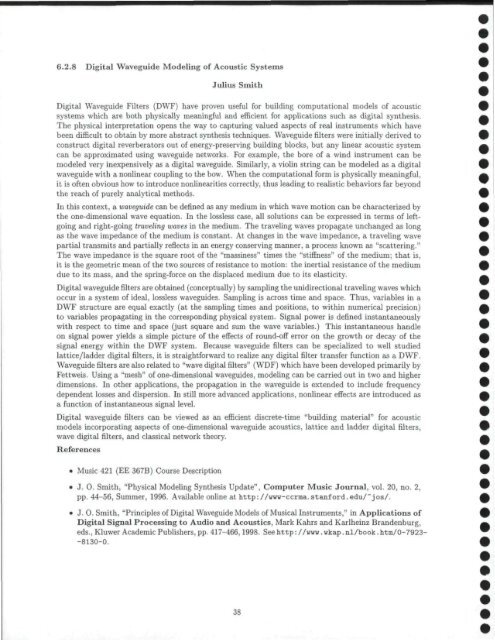CCRMA OVERVIEW - CCRMA - Stanford University
CCRMA OVERVIEW - CCRMA - Stanford University
CCRMA OVERVIEW - CCRMA - Stanford University
Create successful ePaper yourself
Turn your PDF publications into a flip-book with our unique Google optimized e-Paper software.
6.2.8 Digital Waveguide Modeling of Acoustic Systems<br />
Julius Smith<br />
Digital Waveguide Filters (DWF) have proven useful for building computational models of acoustic<br />
systems which are both physically meaningful and efficient for applications such as digital synthesis.<br />
The physical interpretation opens the way to capturing valued aspects of real instruments which have<br />
been difficult to obtain by more abstract synthesis techniques. Waveguide filters were initially derived to<br />
construct digital reverberators out of energy-preserving building blocks, but any linear acoustic system<br />
can be approximated using waveguide networks. For example, the bore of a wind instrument can be<br />
modeled very inexpensively as a digital waveguide. Similarly, a violin string can be modeled as a digital<br />
waveguide with a nonlinear coupling to the bow. When the computational form is physically meaningful,<br />
it is often obvious how to introduce nonlinearities correctly, thus leading to realistic behaviors far beyond<br />
the reach of purely analytical methods.<br />
In this context, a waveguide can be defined as any medium in which wave motion can be characterized by<br />
the one-dimensional wave equation. In the lossless case, all solutions can be expressed in terms of leftgoing<br />
and right-going traveling waves in the medium. The traveling waves propagate unchanged as long<br />
as the wave impedance of the medium is constant. At changes in the wave impedance, a traveling wave<br />
partial transmits and partially reflects in an energy conserving manner, a process known as "scattering."<br />
The wave impedance is the square root of the "massiness" times the "stiffness" of the medium; that is,<br />
it is the geometric mean of the two sources of resistance to motion: the inertial resistance of the medium<br />
due to its mass, and the spring-force on the displaced medium due to its elasticity.<br />
Digital waveguide filters are obtained (conceptually) by sampling the unidirectional traveling waves which<br />
occur in a system of ideal, lossless waveguides. Sampling is across time and space. Thus, variables in a<br />
DWF structure are equal exactly (at the sampling times and positions, to within numerical precision)<br />
to variables propagating in the corresponding physical system. Signal power is defined instantaneously<br />
with respect to time and space (just square and sum the wave variables.) This instantaneous handle<br />
on signal power yields a simple picture of the effects of round-off error on the growth or decay of the<br />
signal energy within the DWF system. Because waveguide filters can be specialized to well studied<br />
lattice/ladder digital filters, it is straightforward to realize any digital filter transfer function as a DWF.<br />
Waveguide filters are also related to "wave digital filters" (WDF) which have been developed primarily by<br />
Fettweis. Using a "mesh" of one-dimensional waveguides, modeling can be carried out in two and higher<br />
dimensions. In other applications, the propagation in the waveguide is extended to include frequency<br />
dependent losses and dispersion. In still more advanced applications, nonlinear effects are introduced as<br />
a function of instantaneous signal level.<br />
Digital waveguide filters can be viewed as an efficient discrete-time "building material" for acoustic<br />
models incorporating aspects of one-dimensional waveguide acoustics, lattice and ladder digital filters,<br />
wave digital filters, and classical network theory.<br />
References<br />
• Music 421 (EE 367B) Course Description<br />
• J. 0. Smith, "Physical Modeling Synthesis Update", Computer Music Journal, vol. 20, no. 2,<br />
pp. 44-56, Summer, 1996. Available online at http://www-ccrma.stanford.edu/~jos/.<br />
• J. 0. Smith, "Principles of Digital Waveguide Models of Musical Instruments," in Applications of<br />
Digital Signal Processing to Audio and Acoustics, Mark Kahrs and Karlheinz Brandenburg,<br />
eds., Kluwer Academic Publishers, pp. 417-466,1998. See http://www.wkap.nl/book.htm/0-7923-<br />
-8130-0.<br />
3S

















